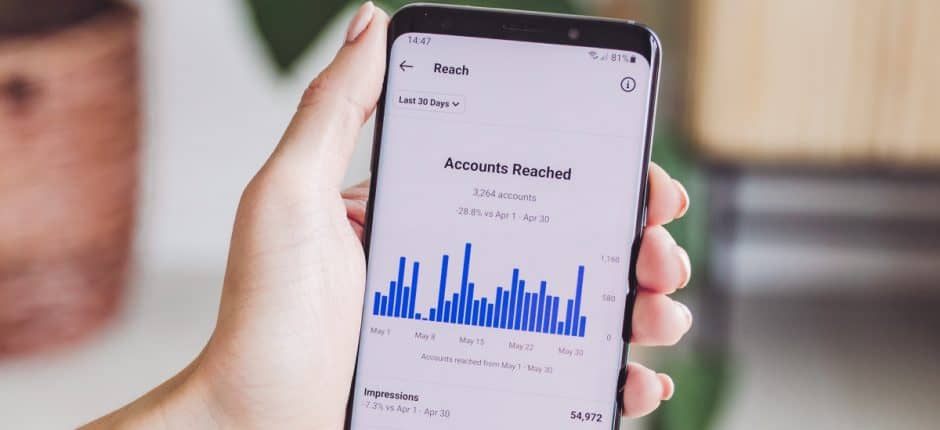Impressions vs reach—which is more important and how do they differ from one another? Knowing the difference between key metrics like these is critical for making the most of Instagram for your business. Knowing what they mean can provide powerful insights into what’s working and what’s not.
While these two metrics are similar, use this guide to understand the difference so you can set goals for growth and create content that wows your target audiences.
Keep Reading: 7 Steps to Organically Increase Your Instagram Followers
What is Reach?
Reach refers to the number of unique people who are exposed to a piece of content. There are multiple factors that play into your potential reach. If you have 1,000 followers then, in theory, you start with a potential reach of 1,000 people.
However, Instagram uses an algorithm model, which means it only shows some pieces of content to certain audiences. In addition, hashtags, profile tagging, and your profile’s engagement and consistency all play a role in how many people each post and story actually reaches.
Feed Post Reach
A 2021 report by Rival IQ breaks down the reach rate among followers, for feed posts based on the size of the account:
- Less than 10K: 25% reach rate
- 10K – 50K: 24% reach rate
- 50K – 200K: 18% reach rate
- 200K or higher: 12% reach rate
The takeaway: the larger the following, the fewer followers you reach. However, reach data includes all unique users, not just followers—and this is why it’s important to optimize your content to reach people outside your network, via:
- Implementing a strong hashtag strategy
- Getting shares
- Tagging relevant people and brands
- Writing compelling content
- Using high-quality imagery and video
You can see this breakdown for yourself in your own Instagram insights. Within the platform, find this by going to Insights > Insights Overview > Accounts Reached. See my reach insights for the last 30 days below:

Story Reach
Note that reach rates are significantly lower for Story posts, ranging from 6.5 percent for accounts with less than 10K followers to just 1.5 percent for those with 200K followers. Again, you can increase your Story reach by using hashtags and tagging your location, along with tagging other people who will then re-share it.
Keep Reading: 10 Instagram Story Ideas to Boost Engagement
What are Impressions?
Impressions refer to the number of times a piece of content was displayed to a member of your audience. While a single audience user can only count for one person in your reach, they may account for multiple impressions. In this way, you can see a reach of just 1 or 2 but have multiple impressions.
If you have higher impressions than reach, that means people are likely coming back to your content, a sign that they like what you’re putting out there.
While there are no global benchmarks for average impressions, you can set your own benchmarks. To find overall impressions for your content, you’ll need to use a tool like Planoly since Instagram doesn’t provide an overall number, but only gives you data on impressions per post.
Below is a screenshot of how Planoly provides this data—what you’re looking at are average impressions but you can look specifically at Story or feed impressions.

Keep Reading: Planoly vs Later: How to Choose the One for You
Why Reach and Impressions Are Important
These metrics are important because they tell you if your content is resonating and how well you’re amplifying your content. The more you know about what’s working, the greater your community will grow.
But don’t just look at the numbers. Here are a few key considerations to make as you analyze the data.
Similarities between your posts with the highest reach or impressions: You can find this data in Instagram by navigating to Insights > Content You Shared (posts) and then toggling to reach or impressions at the top. Ultimately, this tells you what you need to do more of to continue expanding your reach.
Audience engagement based on reach or impressions: If you have a high number of impressions and reach but low engagement, it stands to reason that your posts aren’t motivating people to take action or resonating with your audience. Ultimately, engagement plays a key factor in both the Facebook and Instagram algorithms. When users engage with a post, the social network will show the content to more people, driving up reach, impressions, and engagement.
Reach differences between followers and non-followers: Your goal is to expand your reach beyond your followers so you can attract more people to your community. In the screenshot above, you see Instagram breaks down reach between followers and non-followers. If your reach to non-followers is declining, or continually low, consider how you can cast a wider net using hashtags and creating content that people want to share.
Use Impressions and Reach to Guide Your Content Creation
Without the right data, it’s impossible to know what’s working and what’s not. While there are many metrics to track engagement and growth, knowing the difference between impressions vs reach can help you get the most out of each data point. More importantly, they can help guide you to understand which content is resonating most, whether you need to cast a wider net, and how your ideal audience is consuming your content—if at all. Don’t ignore these two metrics if you want to make Instagram work for your business.




